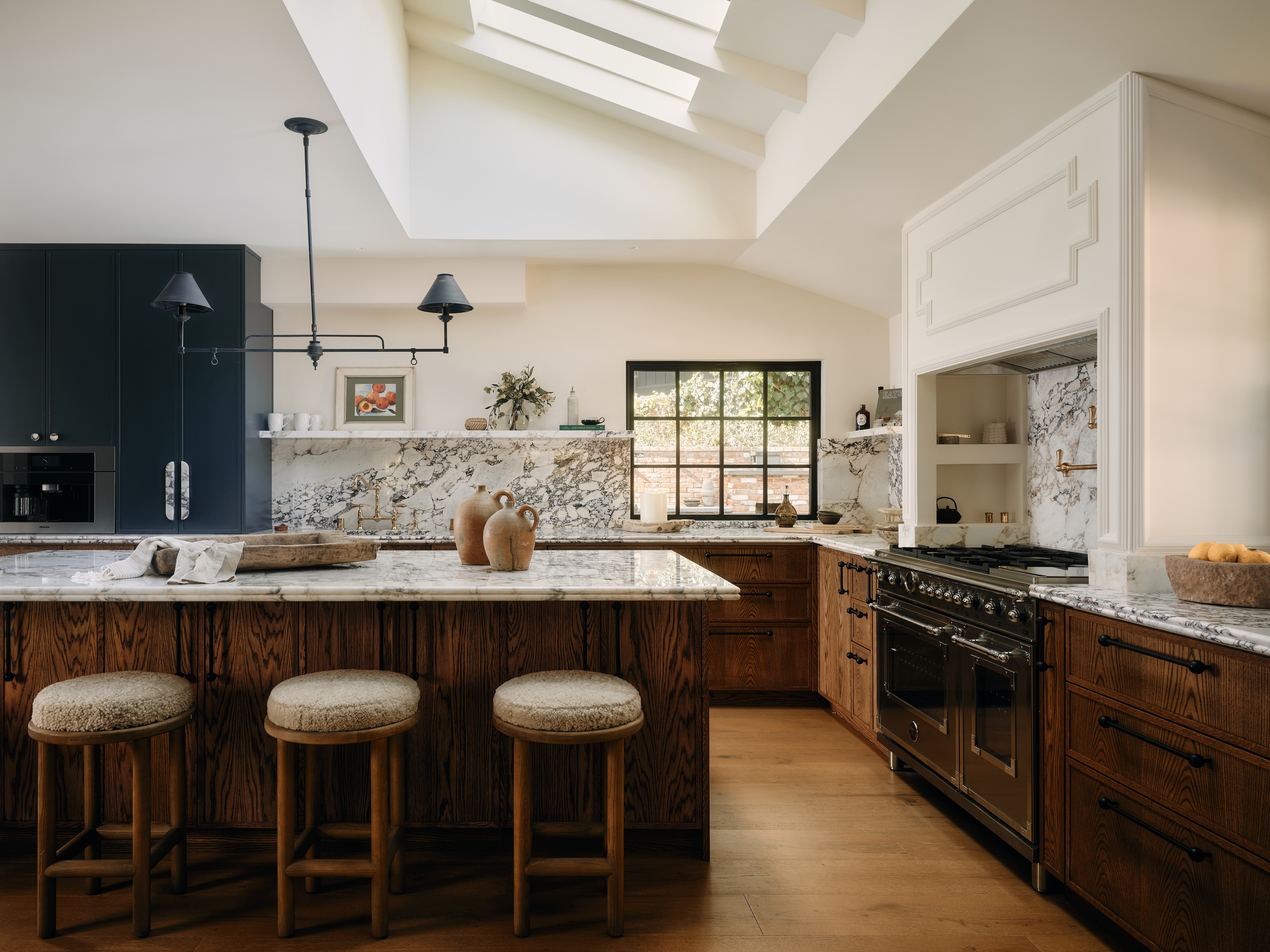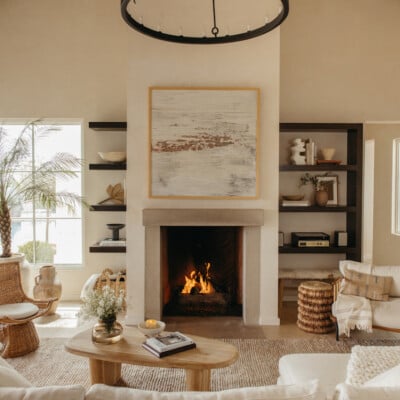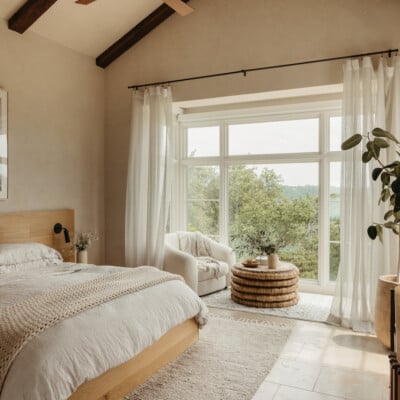How do you know when you’ve finally “made it” in the notoriously tough world of fashion? Maybe it’s when you’re awarded one of the ten coveted spots in the CFDA’s Incubator Program. Or maybe it’s when Cindy Crawford’s daughter, Kaia Gerber, is rocking one of your designs in the September issue of Vogue. Or maybe, just maybe, it’s when Lauren Santo Domingo herself selects your spring line to be available on Moda Operandi. All of this and more has happened for designer Whitney Pozgay of WHIT in the last two years, and we’ve watched as our favorite little secret line of ready-to-wear became, well, not so secret anymore. We love WHIT clothes for the way they make us feel — like that cool girl who might ditch the gallery opening to go ride the rides at Coney Island. With bright prints and bold shapes, Whitney’s designs prove that sophistication and fun can joyfully co-exist. We dropped by her New York studio in September to chat with the designer (and even scored a front row seat at her Spring 2016 show!) Fashionistas get ready: you’re about to get a major backstage peek at this total dream job.
photographed by belathée photography

First of all — we’re huge fans of your line. I seriously can’t wear a WHIT piece out of the house without getting a compliment. They’re so well-tailored, and in such amazing fabrics. I always feel special when I’m wearing something by WHIT. When did you know you wanted to become a fashion designer? Is it something you were in touch with from a young age?
I was always a creative child and interested in making things, but it wasn’t specifically fashion focused. I was really into art and theater. However, I loved dressing up and playing in my mom’s closet. I was intrigued with the concept of “glamour”. I was also into vintage at an early age and have always loved prints.

Did you study fashion design in school? Do you have any formal training that gave you an edge in your field?
I actually went to UT Austin as a Theater major. I began with an acting concentration, but fell in love with costume design. By the end of school, I was much more costume focused. When I was a senior I designed the costumes for one of the main stage shows and while I loved the experience, I was sad to see them boxed up at the end of the run. I loved the idea of designing pieces for the real world that would have their own story. The same item could be interpreted by whoever chose to wear it and I found that romantic. When I moved to New York I took night school at FIT and Parsons to bridge the gap between fashion and my costume design training.

What do you love about what you do?
I really like seeing ideas come to life, but I also love collaborating with other creatives. We work with different artists and friends each season and that is the most rewarding part. We are lucky to have such an amazing creative community around us and it is really fun to think of new ways to work together each season. It keeps us feeling refreshed. I also have the pleasure of working with my husband Parker on WHIT. We are complementary creative partners and get to collaborate on most of the line.

Tell us a bit about your design process. When you’re designing a new collection, where do you start? Is it with one great piece? A general theme or idea? Where do you look for inspiration?
I lot of the processes overlap, but I like to start with an overall mood or general theme. Then we focus on artwork and prints first, then build bodies and constructions from there. I’m constantly looking for inspiration. It often comes from art, but I am often inspired by travel, muses, the city, nature and architecture as well. Nothing is off limits.

Is WHIT a reflection of your personal style? Or is the WHIT girl a vision that’s larger than yourself?
I think it is in part a reflection of my “ideal” personal style. More and more as a designer, I find myself falling back on certain uniforms and focusing my creativity on WHIT. I also like to think of the WHIT girls in terms of spirit and personality rather than a specific style. I don’t want to put our girl in a box. I love seeing women putting their own personal spin on WHIT.

Tell us a little about your career path: We know you started at Kate Spade and then moved on to head of womenswear at Steven Alan. Do you feel it’s important to “pay your dues” in the fashion industry before launching out on your own? How did those two experiences shape your personal sense of style?
For me it was important to learn the business and see how other companies functioned. No matter how confident you might be in your designs, the creative process is only one part of running a business. I was lucky to see how different departments worked together on a bigger scale at Kate Spade and at Steven Alan. It helped me to know what all needed to be covered, even if it was going to be on a much smaller scale.
From a design perspective I learned important lessons from both about brand building and staying true to your message. Kate’s playful feminine aesthetic was so strong and visible in every corner of that company. There I was able to nurture my passion for vintage prints and color. Steven’s irreverent tomboy look gave me a chance to indulge my love of clean shapes and classic fabrics. My aesthetic lies somewhere in between and I think those experiences helped shape my idea of who I wanted to design for.

Was there a “big break” moment in your career? How did you land that opportunity?
I don’t know that there was one “big break” or “aha” moment, but there have been a series of pivotal successes that have been important. I think the most substantial one for us was being accepted into the CFDA Incubator. They paired us with business mentors and helped us focus our voice. It gave us confidence to stand behind what we were building and to push it further. We are still waiting for the BIG one…

Do you know how to sew? Is that a necessary skill to develop for a career in design?
I took sewing in school and know how to use a machine. Am I a great sewer? Not really, and I am terribly out of practice. Our collections are now 60 styles a season so we work with a sample house. However, I do think that it is extremely important to at least know how to sew. Knowledge of garment construction is paramount. You need to know what makes something fit well and how to correct when it doesn’t.

How many collections do you produce per year?
Three: Fall, Resort and Spring.

We know that your husband, Parker, is one of your partners with WHIT. What does Parker contribute to the line and the design process? (And, also, what’s it like working with your significant other all day?!)
We are creative partners in crime. We work really closely on all aspects of the line, but he spear heads most of the creative outside of the design. We work together on the print concepts and he actually hand paints a lot of the prints that we use. I love working together, but sometimes it is a challenge to NOT talk about work. We try to set time aside where work talk is not allowed, but then one of us has an idea and that’s the end of that. (haha!) I feel really fortunate to work so well together and enjoy it.

We love all the amazing prints and patterns you use. Do you produce the textiles yourself or do you source them from other manufacturers?
All of our prints are custom. Occasionally, we will find a vintage pattern that we adore and will to adjust and add to the line, but most all of the prints and patterns are created from scratch either by Parker, myself or other artist collaborators. We work with various printing mills and weavers to them bring the artwork to life. I love textiles and custom fabrics are a major part of our line.

When it comes to fashion design, what’s the best advice you’ve ever been given?
You can’t be everything to everyone. No one is coming to us for a basic black pant, so I don’t have to make that.

You’re known for being a part of the garment district revival in New York. What are the costs and benefits to having your manufacturing done in the states?
I am passionate about making goods in New York. We make most of our mainline here and I really like being so hands on with the process. It is definitely more labor intensive and more expensive, but the quality is fantastic and I have a first hand knowledge of the sewers, their conditions, their skills and can work with them very easily to problem solve if anything happens during production. I am happy to see that some of the larger designers are moving at least part of their production back to New York.

If you didn’t design clothes for a living, what else would you do?
I would love to have a candy/book store/flower shop one day.

Okay, so we’re dying to know about the fashion shows. How many shows do you put on per year? What goes in to producing a show during Fashion Week?
We do two a year. Bringing a collection to life and creating an environment serves as a satisfying crescendo before opening for market. Being able to add music, a set, and models gives us a chance capture the season’s concept as full experience. It also lets me tap into old theater roots.

Walk us through your typical day — are you sketching new designs? Casting models? At the sewing machine?
It really depends on where things fall in the schedule. Right now we are in the middle of fall development, which is the best part. In the morning I try to knock my business meetings and calls out of the way so that I can focus the rest of the day on fabric appointments, developing prints, meeting with collaborators, sketching shapes, and line planning.

What’s the hardest part of your job that no one sees from the outside?
The time management is tough. There are so many moving parts and not all of it fun. We are a really small team, and I spend a lot of time dealing with operations, sales, PR, accounting, and production. I have to be diligent in setting time aside to design and be creative.

Whitney’s spring 2016 collection was inspired by the idea of “colorful hot air balloons over the savannah” and features plenty of fun tribal touches.

We’re kind of obsessed with WHIT Two, your line for petities at Anthropologie. What inspired doing a line just for petites? And what do you love about working with Anthro?
Anthro has such a strong voice and message. They are incredible to work with and know their customer really well. We have been able to collaborate with them on WHIT TWO as a whimsical accessible sister to WHIT. Their petites business had become really strong and they wanted to bring us on to offer print and details to petites that we not usually part of the offering. Old fashioned notions about petite styling steered away from print and certain lengths, but we feel that it is just a matter of proper proportions for shorter frames. It has been very exciting to see how the petite business has done with Anthropologie and we are now offering regular sizing as well.
Jewelry created in collaboration with Hoist and Lee.

Models rock twenty different looks from WHIT’s spring 2016 ready-to-wear collection.

Describe WHIT in 5 words or fewer:
Positive Clean Modern Artful Graphic

If you could dress any celebrity in WHIT, who would it be?
Sia

Where do you see yourself (and WHIT) in ten years?
I would like to expand into other categories and have a few brick-and-mortar shops where we could sell not only WHIT but other things that we love.

So if we really begged you, would you please start designing WHIT swimwear? (It’s just that we know it would be so cute…)
Ha! We have been getting a lot of requests for swim lately! We are planning to launch swim in the next year. Stay tuned…

What advice would you give to a young woman looking to get started in fashion?
Get ready to work. While it looks glamorous on the outside (and there are parts that are) it is also a lot of hard work and long hours. You have to love it and you have to be scrappy. I think interning is important and figuring out which part of fashion you are most interested in. A lot of the girls we see just out of school are often surprised at how physical the job is and how much work is involved. Most importantly, always be looking for inspiration outside of fashion.
Thank you, Whitney, for giving us a glimpse inside your total dream job.
follow whit on instagram: @whit_ny
shop her spring collection on moda operandi





This is amazing! Truly a dream job, and gorgeous photography!
Great post Jen about a great person!